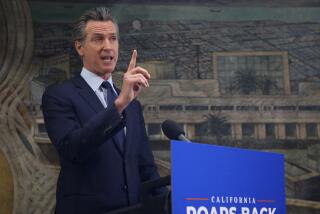Panning for gold -- in D.C.
Last month, a flock of Californians streamed through Washington’s halls of power seeking federal money for the state’s slumping economy, gridlocked transportation system and troubled schools. To their delight, they found a Democratic administration with a sympathetic ear for the state’s problems -- plus a big bag of stimulus funding to spend.
“There’s never been so much money in D.C. waiting to be shipped out to the states,” marveled lawyer and MTA Director David W. Fleming after a visit to the White House. “It’s like a huge trail of breadcrumbs.”
But as federal spending is being parceled out, it’s beginning to look as if California won’t quite find the whole loaf of bread it hoped for.
Yes, the stimulus package is big: $787 billion. And California is getting big chunks of that money for some of its most painful needs, such as extended unemployment benefits and job training. But that’s partly a reflection of the depth of the state’s troubles. A portion of the stimulus money is being allocated to states on the basis of need, and at 10.5%, California’s unemployment rate is the fifth-highest in the nation, behind Michigan, Oregon and the Carolinas.
In other spending categories, California didn’t come out so well. In highway construction, for example, only about 9% of federal money is coming California’s way, although the state has about 12% of the population.
“We still don’t get our share most of the time,” said Bruce Cain, director of the University of California’s Washington Center. “It would be worse if we weren’t in there fighting.”
And because most of the stimulus is earmarked for specific uses, it won’t be much use in filling the state’s huge budget gap.
Part of the problem lies with Congress, where small states wield far more power than their population numbers justify. Take Wyoming. With the nation’s lowest unemployment rate -- 3.9% -- the state really doesn’t need much help. But the first wave of state-by-state allocations sends $723 per resident to California and $979 per resident to Wyoming, according to estimates compiled by Federal Funds Information for States, a nonpartisan analysis group.
Believe it or not, California’s allocation was a significant victory for Rep. Henry A. Waxman and others in the state’s congressional delegation, who made sure that money to help the unemployed would go to states with high unemployment rates, education funding to states with lots of schoolchildren and so on.
As a result, California is on track to get almost 12% of the total stimulus package. This sounds good -- it’s about in line with the state’s population -- but the state is one of the hardest hit by the recession. And if the stimulus is really aimed at pulling us out of tough times, it should be aimed at the places that need it most.
President Obama has said nice things about California, named some Californians to his Cabinet and visited the state more quickly than his predecessor did -- but he has also made it clear that he’s focused on fixing the national economy, not any one region.
“California oftentimes gets hit worse when recessions come, but you also rise up faster when the economy starts to recover,” Obama said when he visited Los Angeles on March 19. “So I’m confident California will continue to be on the cutting edge of our economy.”
Last month, when all those Californians were visiting Washington, Gary Toebben, president of the Los Angeles Area Chamber of Commerce, put the arm on Larry Summers, Obama’s chief economic advisor. If you want to revive the nation’s economy, start with its biggest state, Toebben urged.
But Summers turned the point around, saying he hoped Californians would use their renowned creativity to lead the country out of its economic ditch. Translation: No special bailout for California, folks.
L.A. Mayor Antonio Villaraigosa tried a less parochial pitch and urged Summers to focus on the cities, where most Americans live. “You fix the problems of New York, Chicago, L.A., Miami, Houston, you’ve fixed 80% of the problems in the country,” the mayor said.
That was a more effective argument. Much of the stimulus package hasn’t been allocated yet, and California’s hopes of winning a bigger slice may rest largely on the new administration’s more urban focus. That isn’t surprising in a Democratic presidency; the gulf between urban Democrats and rural Republicans is one of the deepest divisions in American politics, even within the borders of California.
Los Angeles and other cities still face an uphill struggle for federal money, even in the age of Obama. Now that the economy has shown some initial signs of recovery, the administration isn’t talking about a second stimulus package anymore. Instead, it’s worrying about how it will pay for healthcare reform and a middle-class tax cut. It’s not looking like that $6-billion “subway to the sea” is going to be running any time soon.
Villaraigosa acknowledged that he left Washington last month without any major new funding commitments in hand. But he said he was happy just to have a chance to compete for money for mass transit, schools and policing.
“This is like fishing,” he told me. “We’re throwing out the cast. Now what we need is a little patience.” Still, as any fisherman can tell you, he’ll need more than patience; he’ll need some luck.
--
More to Read
Sign up for Essential California
The most important California stories and recommendations in your inbox every morning.
You may occasionally receive promotional content from the Los Angeles Times.











